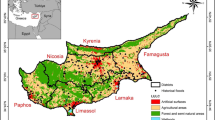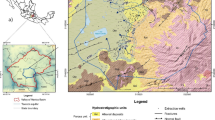Abstract
The complex and controversial task of selecting a dam site in a river basin can be successfully achieved using science-informed multi-criteria decision-making (MCDM) techniques. In this paper, we describe the application of the group fuzzy TOPSIS model for optimal ranking of the case study of Kandoleh dam sites in Kermanshah province, Iran, involving 18 input criteria. In this study, decision-making committee was made up of 20 involved decision makers. The comments of four non-biased, external experts in dam site selection were also used. The triangular fuzzy numbers were used to apply experts’ opinions on the selection criteria. In total, four alternative sites were assessed based on the technical, economic, social and environmental considerations and the data were analyzed using fuzzy TOPSIS MCDM model. Ranking results were compared with multi-criteria decision-making models, including the ELimination and Choice Expressing the REality and simple additive weighting. This logical, open and transparent framework provides a science-informed decision-making approach for complex problems such as optimal dam site selection. Finally, using sensitivity analysis, local studies and group discussions, we demonstrated the multiple benefits of the proposed novel method for a science-informed, open and transparent method for optimal ranking of the dam site candidates.

(reproduced with the permission from Kahraman et al. 2003)








Similar content being viewed by others
References
Afshari A, Mojahed M, Yusuff RM (2010) Simple additive weighting approach to personnel selection problem. Int J Innov Manag Technol 1(5):511
Atieh M, Gharabaghi B, Rudra R (2015) Entropy-based neural networks model for flow duration curves at ungauged sites. J Hydrol 529(3):1007–1020
Atieh M, Taylor G, Sattar AM, Gharabaghi B (2017) Prediction of flow duration curves for ungauged basins. J Hydrol 545:383–394
Benayoun R, Roy B, Sussman N (1966) Manual de reference du programme ELECTRE. Note de synthese et Formation, No. 25, Direction Scientifique SEMA, Paris, France
Cegan JC, Filion AM, Keisler JM, Linkov I (2017) Trends and applications of multi-criteria decision analysis in environmental sciences: literature review. Environ Syst Decis 37:123–133
Chen CT (2000) Extensions of the TOPSIS for group decision-making under fuzzy environment. Fuzzy Sets Syst 114(1):1–9
Chen JK, Chen IS (2010) Using a novel conjunctive MCDM approach based on DEMATEL, fuzzy ANP, and TOPSIS as an innovation support system for Taiwanese higher education. Expert Syst Appl 37(3):1981–1990
Chen SJ, Hwang CL (1992) Fuzzy multiple attribute decision making: methods and applications. Springer-Verlag, New York
Figuera J, Greco S, Ehrgott M (2005) Multiple criteria decision analysis, state of the art surveys. Springer-Verlag, New York
Gazendam E, Gharabaghi B, McBean E, Whiteley H, Kostaschuk R (2009) Ranking of waterways susceptible to adverse stormwater effects. Can Water Resour J 34(3):205–228
Hwang CL, Yoon K (1981) Multi-attribute decision making: methods and applications. Springer-Verlag, Berlin, Germany
Kahraman C, Cebeci U, Ulukan Z (2003) Multi-criteria supplier selection using fuzzy AHP. Logist Inf Manag 16(6):382–394
Kahraman C, Onar S, Oztaysi B (2015) Fuzzy multicriteria decision-making: a literature review. Int J Comput Intell Syst 8(4):637–666
Kodikara PN, Perera BJC, Kularathna MDUP (2010) Stakeholder preference elicitation and modelling in multi-criteria decision analysis: a case study on urban water supply. Eur J Oper Res 206(1):209–220
Kurth MH, Larkin S, Keisler JM, Linkov I (2017) Trends and applications of multi-criteria decision analysis: use in government agencies. Environ Syst Decis 37:134–143
MacCrimmon KR (1968) Decisionmaking among multiple-attribute alternatives: a survey and consolidated approach (No. RM-4823-ARPA). RAND CORP SANTA MONICA CA
Minatour Y, Khazaie J, Ataei M (2013) Earth dam site selection using the analytic hierarchy process (AHP): a case study in the west of Iran. Arab J Geosci 6(9):3417–3426
Minatour Y, Bonakdari H, Zarghami M, Bakhshi M (2015a) Water supply management using an extended group fuzzy decision-making method: a case study in north-eastern Iran. Appl Water Sci 5(3):291–304
Minatour Y, Khazaie J, Ataei M, Javadi AA (2015b) An integrated decision support system for dam site selection. Sci Iran Transa A Civ Eng 22(2):319
Mousavi S, Makoui A, Raissi S, Mojtahedi S (2012) A multi-criteria decision-making approach with interval numbers for evaluating project risk responses. Int J Eng 25(2):121–129
Netto OC, Parent E, Duckstein L (1996) Multicriterion design of long-term water supply in southern France. J Water Res Plan Manag 122(6):403–413
Niemczynowicz J (1999) Urban hydrology and water management—present and future challenges. Urban Water 1(1):1–14
Okeola OG, Sule BF (2012) Evaluation of management alternatives for urban water supply system using Multicriteria Decision Analysis. J King Saud Univ Eng Sci 24(1):19–24
Opricovic S, Tzeng GH (2002) Multicriteria planning of post-earthquake sustainable reconstruction. Comput Aided Civil Infrastruct Eng 17(3):211–220
Podvezko V (2011) The comparative analysis of MCDA methods SAW and COPRAS. Inzinerine Ekonomika Eng Econ 22(2):134–146
Rogers M, Bruen M (1998) A new system for weighting environmental criteria for use within ELECTRE III. Eur J Oper Res 107(3):552–563
Roghanian E, Rahimi J, Ansari A (2010) Comparison of first aggregation and last aggregation in fuzzy group TOPSIS. Appl Math Model 34(12):3754–3766
Saaty TL (1996) Decision making with dependence and feedback: the analytic network process. RWS Publications, Pittsburgh
Satty TL (1980) The analytical hierarchy process. McGraw-Hill, New York
Shannon CE (2001) A mathematical theory of communication. ACM Sigmobile Mob Comput Commun Rev 5(1):3–55
Srdjevic B, Medeiros YD (2008) Fuzzy AHP assessment of water management plans. Water Resour Manag 22(7):877–894
Tecle A, Fogel M, Duckstein L (1988) Multicriterion selection of wastewater management alternatives. J Water Res Plan Manag 114(4):383–398
Tzimopoulos C, Balioti V, Evangelides C (2013). Fuzzy multi-criteria decision making method for dam selection. In: Proceedings of the 13th international conference on environmental science and technology, CEST Athens, Greece
Wang TC, Chang TH (2007) Application of TOPSIS in evaluating initial training aircraft under a fuzzy environment. Expert Syst Appl 33(4):870–880
Wang YJ, Lee HS (2007) Generalizing TOPSIS for fuzzy multiple-criteria group decision-making. Comput Math Appl 53(11):1762–1772
Wang JW, Cheng CH, Huang KC (2009) Fuzzy hierarchical TOPSIS for supplier selection. Appl Soft Comput 9(1):377–386
Weng SQ, Huang GH, Li YP (2010) An integrated scenario-based multi-criteria decision support system for water resources management and planning: a case study in the Haihe River Basin. Expert Syst Appl 37(12):8242–8254
Yoon KP, Hwang CL (1995) Multiple attribute decision making: an introduction, vol 104. Sage Publications, London
Zimmermann HJ (2001) Fuzzy set theory and its applications. Springer, New York
Zyoud SH, Fuchs-Hanusch D (2017) A bibliometric-based survey on AHP and TOPSIS techniques. Expert Syst Appl 78:158–181
Author information
Authors and Affiliations
Corresponding author
Appendices
Appendix 1: TFNs of experts’ opinion about the criteria importance
See Table 15.
Appendix 2: TFNs of experts’ opinion for evaluation of the alternatives in relation to criteria
See Table 16.
Rights and permissions
About this article
Cite this article
Noori, A., Bonakdari, H., Morovati, K. et al. The optimal dam site selection using a group decision-making method through fuzzy TOPSIS model. Environ Syst Decis 38, 471–488 (2018). https://doi.org/10.1007/s10669-018-9673-x
Published:
Issue Date:
DOI: https://doi.org/10.1007/s10669-018-9673-x




